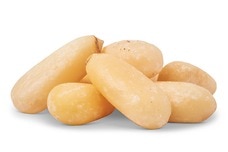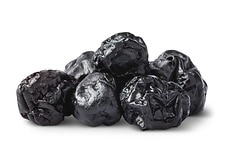Food & Snack Sources of Vitamin K
The body gets its energy from carbohydrates, protein, and fat, but it also depends on vitamins and minerals for healthy functioning. These micronutrients promote enzymatic reactions and keep cells healthy. Vitamin K is a particularly important vitamin for cellular health. It is one of four fat-soluble vitamins (the others are vitamins A, D, and E), meaning that excess amounts are stored in fat tissue.
What Is Vitamin K?
Vitamin K is actually not a single compound but actually refers to a group of vitamins; and, the different subtypes may each have different effects within the body. There are three natural forms of the vitamin: K1, K2, and K3 (WH Foods, 2015). The most abundant form is vitamin K1, which is found in a variety of plant foods. Vitamins K2 and K3 are synthesized by bacteria. Thus, these subtypes of vitamin K can be found in high concentrations in fermented foods. The body can also convert vitamins K1 and K3 to vitamin K2 when necessary.
Physiological Role of Vitamin K
The “K” in vitamin K actually stands for the German word for coagulation (koagulation). This is because it was first discovered for its role in blood clotting (Booth, 2014). The blood contains several clotting factors that depend on the presence of vitamin K to function. Without vitamin K, the blood does not coagulate properly, meaning that a person may continue bleeding after suffering an injury.
In addition to its role in blood clotting, vitamin K is used for a variety of other cellular processes. It is important for enzymatic reactions, maintenance of strong bones, and regulation of cardiovascular functioning. In bones, vitamin K prevents osteoclasts -- cells that break down bone tissue -- from becoming overactivated. The vitamin also affects bone structure in a way that makes it less likely to fracture (Booth, 2014).
Vitamin K Daily Recommended Intake
The National Institutes of Health (2016) have set recommended daily intakes for vitamin K. Adult men need 120 micrograms of vitamin K per day, while adult women need 90 micrograms. Unlike some other vitamins and minerals, pregnant or breastfeeding women do not need more of the vitamin.
Failing to get enough vitamin K in your diet may cause a nutritional deficiency. Vitamin K deficiency is rare among adults, although people with chronic diseases that cause malabsorption of nutrients may be at risk. Symptoms of vitamin K deficiency include bruising easily, blood clotting problems, bloody stool or urine, and excessive menstrual bleeding.
Healthy Food and Snack Sources of Vitamin K
Vitamin K is readily found in a variety of foods, many of which are plant based. Dark green vegetables are sources of vitamin K1. For example: eating plenty of kale, collard greens, Brussels sprouts, pumpkin, pine nuts, blueberries, spinach, turnip greens, or broccoli can help you get enough (National Institutes of Health, 2016).
Vitamin K2 is more often found in fermented foods. For example, fermented soybeans (such as natto, miso, tempeh, and soy sauce) are sources of vitamin K2. Low amounts of vitamin K are found in dairy products like cheese or yogurt.
Recipes Containing Vitamin K
The following recipes offer ways to add additional vitamin K to your diet with recipes that are all-around healthy.
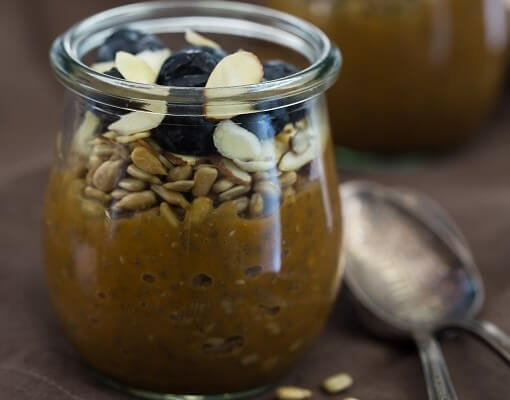
Pumpkin Chia Seed Pudding Recipe
This palatable pudding provides a culinary treat that combines several sources of the vitamin, including both pumpkin and blueberries. The recipe is easy to follow for a quick breakfast that is also full of both protein and fiber.
Ingredients: Milk, pumpkin puree, chia seeds, maple syrup, pumpkin spice, sunflower seeds, sliced almonds, fresh blueberries.
Total Time: 10 minutes
| Yield: 4 servings
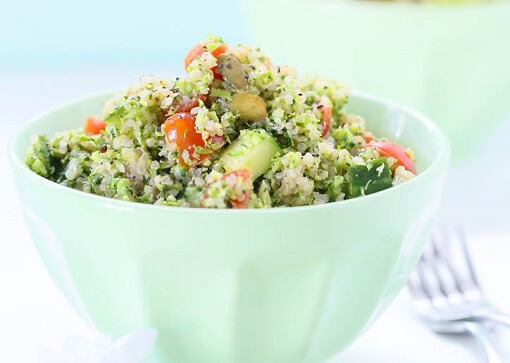
Broccoli Quinoa Salad Recipe {gluten-free}
Broccoli is a superfood that supplies so many of the essential nutrients we need that recipes that make use of it are often among the most wholesome. Just half a cup of broccoli supplies more than 100% of the Daily Value for vitamin K.
Ingredients: Fresh broccoli, quinoa, cucumber, cherry tomatoes, raw pumpkin seeds, sea salt, black pepper, Dijon mustard (optional), vinegar, extra virgin olive oil, maple syrup.
Total Time: 1 hour
| Yield: 8 servings
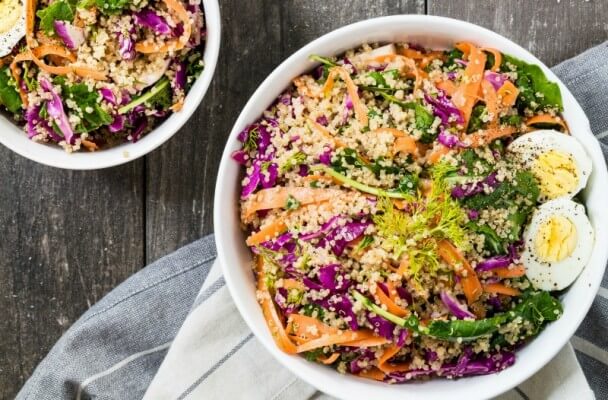
Kale Quinoa Salad Recipe
Kale is another superfood that offers an abundance of different nutrients. Kale and eggs both add to the vitamin K content of this dish, and both ingredients also serve to supply an ample amount of other essential vitamins and minerals.
Ingredients: Quinoa, fresh baby kale, purple cabbage, carrots, fresh dill, boiled eggs, rice wine, extra virgin olive oil, black pepper.
Total Time: 25 minutes
| Yield: 8 servings
Snack Sources of Vitamin K
The following snacks contain vitamin K and offer a great taste to help you add more of the nutrient to your diet!
Healthy Eating
- Healthy Highlights
- 5 Uses for Cacao Powder
- 5 Ways to Eat Farro
- 6 Best Gluten-Free Foods
- Alcohol and the Body
- Almond Flour Recipes
- Anti-Aging Superfoods
- Beat the Afternoon Slump
- Benefits of a Plant-Based Diet
- Benefits of Baobab
- Benefits of Cashews
- Benefits of Coconut Oil for Hair
- Benefits of Coconuts
- Benefits of Dates
- Benefits of Fenugreek
- Benefits of Garcinia Cambogia
- Benefits of Goji Berries
- Benefits of Kale Chips
- Benefits of Monk Fruit Sweetener
- Benefits of Peanuts
- Benefits of Pecans
- Benefits of Pistachios
- Benefits of Pumpkin Seeds
- Benefits of Spelt Flour
- Benefits of Steel Cut Oats
- Benefits of Sunflower Seeds
- Benefits of Tiger Nuts
- Benefits of Turmeric
- Benefits of Walnuts
- Benefits of Wheatgrass
- Best Food Fads
- Cacao vs Cocoa
- Caffeine-Free Energy Foods
- Chocolate That's Good for You
- Diet vs. Exercise
- Fat Burning Foods
- Food Myths Debunked
- Foods for Bone Density
- Foods for Colon Health
- Foods for Healthy Hair
- Foods for Healthy Skin
- Foods to Help Sleep
- Foods to Reduce Stress
- Green Tea Benefits
- Healthy Baking Flours
- Heart Healthy Habits
- High Protein Health Risks
- How to Boost Your Metabolism
- How to Lose Weight While Aging
- How to Throw a Vegan BBQ
- Kaniwa vs Quinoa
- Little Health Foods
- Low-Carb: Fad or Friend?
- Making Healthier Desserts
- Mediterranean Diet Meal Plan
- Natural Beauty Products
- Nuts for Weight Loss
- Preparing Vegan Meals
- Preventing Muscle Degeneration
- Rare Superfoods
- Reduce Sugar Intake
- Save Time By Going Vegan
- Smarter Snack Swaps
- Smoothie Ingredients
- Soy Protein vs Whey Protein
- Starting a Plant-Based Diet
- Steel Cut vs Rolled Oats
- Sugar Substitutes
- Vegan Proteins
- Vegan Substitutions for Fall Recipes
- Why Go Vegan
- Healthy Meals
- Healthy Recipes
- Sports Nutrition
- Nutrition and Special Diets
- 21 Day Fix
- 5 Popular Diet Similarities
- Alkaline Diet
- Anti-Inflammatory Diet
- Calorie Counting
- Carb Cycling Diet
- Celiac Disease
- Cholesterol
- Clean Eating
- Crohn's Disease
- DASH Diet
- Detox Diet
- Diabetes
- Diabetes Diet
- Diet Pill Dangers
- Fat Burning Foods
- Gluten-free Diet
- Glycemic Index
- Heart Health
- High Blood Pressure Diet
- High Fiber Foods
- How to Eat Healthy
- How to Lower Blood Pressure
- Hypertension
- IBS Diet
- Ketogenic Diet
- Liquid Diet
- Low GI Foods
- Low-Carb Diet and Foods
- Low-Fat High-Carb Diet
- Mediterranean Diet
- Mediterranean Diet Foods
- Military Diet
- Nutrition Labels Explained
- Paleo Diet
- Raw Food Diet
- Superfoods
- Sustainable Weight Loss
- Thrive Diet
- Vegan Diet
- Vegetarian Diet
- Weight Loss Shakes
- Whole30
- Vitamins, Minerals & Nutrients



